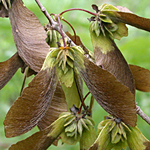

1. Bracts and bracteoles lingulate, spreading, persistent.
1. Bracts and bracteoles ± triangular, appressed or slightly divergent, persistent or deciduous.
2. Calyx with the 4 lateral sepals abaxially biglandular, the anterior sepal eglandular.
3. Calyx glands attached their whole length and borne on free part of sepals; petals yellow, pink, or white, abaxially glabrous; nut of samara laterally compressed, rarely spherical.
Banisteriopsis
3.Calyx glands detached at apex and borne mostly below free part of sepals; petals yellow, abaxially glabrous or hairy; nut of samara spherical.
4. Pedicels short-pedunculate; styles glabrous or basally appressed-pubescent; flowers borne in dense pseudoracemes of 6–45; petals mostly glabrous, very rarely sparsely sericeous abaxially on midrib; nut of samara smooth-sided or bearing a single ridge or winglet on each side parallel to areole; dorsal wing of samara with the basal appendage, if any, shallow, up to 2.5 mm high.
The genera Banisteriopsis, Bronwenia, and Diplopterys are confusing, because they all have 10 fertile stamens, truncate or capitate terminal stigmas, and samaras with a dorsal wing (except the three species of Diplopterys in which that wing has been reduced or lost). The following key distinguishes between the three genera; it is based largely on the descriptions in Gates (1982). For keys to the species of Diplopterys, see Gates (1982); in addition to the four species she treated under Diplopterys, species 67–92 in her treatment of Banisteriopsis are now assigned to Diplopterys.
References: Banisteriopsis (Gates, 1982); Bronwenia (Anderson & Davis, 2007 [pdf]); Diplopterys (Anderson & Davis, 2006 [pdf]).
References: Banisteriopsis (Gates, 1982); Bronwenia (Anderson & Davis, 2007 [pdf]); Diplopterys (Anderson & Davis, 2006 [pdf]).
4. Pedicels sessile; styles bearing long spreading hairs for up to half their length, rarely glabrous; flowers borne in umbels of 4–6 or condensed axillary pseudoracemes of up to 8 pairs; petals abaxially densely or in one species only sparsely sericeous; nut of samara smooth-sided in a few species, mostly alulate or cristate, often with several to many winglets or crests; dorsal wing of samara with the basal appendage usually well developed, up to 10 mm high.
2. Calyx with all 5 sepals eglandular.
5. Pedicels pedunculate; petals pink, paler in age.
5. Pedicels sessile; petals yellow.
6. Plants bearing flowers.
7. Petals abaxially sparsely to densely tomentose or sericeous.
7. Petals glabrous.
8. Flowers produced when plant is leafless.
8. Flowers produced when plant is leafy.
9. Petals all strongly reflexed between sepals.
9. Posterior petal erect or suberect.
Banisteriopsis
6. Plants bearing fruits.
10. Nut of samara smooth-sided, without lateral wings, winglets, or crests.
11. Styles incurved toward the axis apically, densely hairy in the basal third, the hairs spreading, flexuous.
11. Styles erect or diverging and directed away from the axis, glabrous or appressed-sericeous at the base.
Banisteriopsis
10. Nut of samara bearing lateral wings, winglets, or crests.